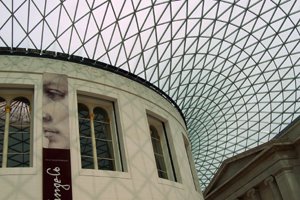
The British Museum is one of the greatest museums in the world. It is the ultimate Enlightenment estblishment, the physical representation of the idea that knowledge should be made available to all to view, interpret, and understand.
In an argument for the preservation of the museum, Hugh Thomas gives a brief summary of its development:
"The British Museum was established in 1753 as a universal Temple of the Arts. Its modern history has, however, been a process of fragmentation. In 1825, the paintings which it owned went to Trafalgar Square, to become the Nationla Gallery. In 1883, the collection of natural history went to South Kensington. In 1905, the nespapers and periodicals went to Colindale; and in 1970, the holdings on ethnography went to Burlington Gardens” (Thomas 1983, 11).
In the mid-90s the library also moved out of the museum. What was once the collection of research materials of the museum, were moved a mile north to a new building on Euston road. This new building was titled "The British Library."
The symbolic value of Enlightenment-based pursuit of knowledge was best represented by the Round Reading Room, the domed, circular structure in the center of the museum's open courtyard. Thomas, on behalf of his “International Committee of the Campaign to Save the Round Reading Room” was campaigning for the "creative" conservation of this majestic space.
The problems with this space is extremely complex, but some features I have recently discovered are extremely interesting. One, the Round Reading Room was a revolutionary peice of environmental engineering rendered useless by modern intervention. A "spider" underneath the library floor circulated cool air through submerged passages up into the library via custom cast iron duct work in the desks. The air was circulated solely by the stack effect of the tall dome. This system worked for 150 years. Foster's intervation in 1995, the Great Court project, sealed the outdoor space, shut all the windows, and replaced the passive air circulation system with a modern HVAC system. Praised as one of the world's leading practitioners of environmental architecture, Foster negated the entire Round Reading Room design.
Second, the Great Court is not part of the British Museum. Technically and leagally, it is a public space that happens to be in the center of the museum. Since all public spaces must be open for use during the day, the British Museum was leagally bound to leave its doors open from morning till night to let people walk through the very center of its collection. This has changed recently, but considerable regulations and restrictions still apply to the Great Court space. For example, you cannot move the tables and chairs without a formal act of the Camden Council.
I will have to elaborate on these points later, as I develop my precedent study, but for now, I think this post is enough.
SOURCE:Thomas, Hugh. The Case for the Round Reading Room. Centre for Policy Studies: London, 1983.